|
HINDUISM
Nanthi flags – their significance
Chelvatamby Maniccavasagar
In the history of the world every nation has stood for a particular
idea which it has sought to weave into the fabric of the lives of the
people. The Germans made the concept of beauty essentially their own,
the rule of law moulded the patern of the Britishers. Likewise, long
before the Greeks and Britishers, the Hindus were told to govern their
lives by the norms of Dharma which comprehends all the excellences which
makes for an ideal humanity.
|
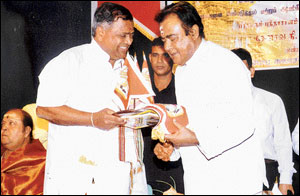
“Vidaikodi Chelvaar” S. Dhanabalaa presents a Nanthi flag to
Prime Minister D.M Jayaratne |
Further, Dharma is an internal discipline by which a given social
order is protected. It is by Dharma that civilization is maintained.
Therefore, Dharma may be defined as social norms or moral law. Since
Nanthi or the Sacred Bull is said to be the vehicle of Lord Shiva, it
also means that Dharma is the vehicle of Lord Shiva. To ordinary Hindus,
Nanthi represents the physical of Shiva in the form of a Bull. Lord
Nanthi is a manifested energy or dynamic motion that is felt in the
invisible and partly visible nature of the micro or macro cosmos and in
the visible objective nature it is a vehicle.
Indeed, there is a flag for every nation, every religion and every
political party without any exception. They hoist their flags during all
important occasions and celebrations and the whole world comes to know
their respective celebrations on account of their flag hoisting
ceremony. But, there is no such flag common to Hindus hoisted during
festivals or ceremonies anywhere in the world.
Nanthi stands for sacrifice, devotion, detachment, perception,
tolerance, humility, service and what is more, it is hailed as God
himself. Therefore, the Nanthy flag signifies all such lofty values of
the Saivites. That really is the significance of the Nanthi flag.
|
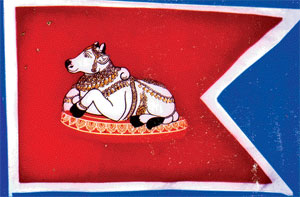
Nanthi flag |
Whenever and wherever Lord Shiva appeared before his ardent devotees
to bestow a boon, he gave dharshan as appearing on his vehicle, Nanthi.
When saint Gnanasampanthar had Siva’s Dharshan for the first time in his
infancy, what he saw was Lord Shiva with his consort on his vehicle
Nanthi. It has been so with all saints and devotees.
Furthermore, in Hinduism every God has an associated vehicle. For
example Lord Ganesha has the rat, Goddess Saraswathy has the Swan and
Lord Muruga has the peacock.
In fact, the flag hoisting ceremony in temples indicates that the
descended Kundalani Sakthy at Moolatharam of our spinal chord should
rise to the head.
|

World Saiva Council (Sri Lanka) Vice President “Vidaikodi
Chelvar” S. Dhanabalaa (JP) presents a Nanthi flag to Member of
Parliament Namal Rajapaksa. |
The flag lowering ceremony indicates that the supreme consciousness
descends down from the head to the body (Creation) and reach the end of
the Spinal Chord (Moolathanam). Further, the hoisting of Nanthi flag at
the top of the Rajagopurams of the temple and in any other religious
organizations will undoubtedly explain the principles and philosophies
of Saivism to achieve the goal of life.
Undoubtedly, the Nanthi flag encapsulates the essence of Hindu-Saiva
thought. It portrays reality, moral and ethical norms.
As such, the Nanthi flag is an apt representation of the Hindus who
are passive yet perceptive, hale yet humble and deep, devout and
detached. Indeed, the hoisting of the Nanthi flag at the top of the
Rajakopurams of the temples and other places of prayers and Meditation
Centres will undoubtedly explain the principles and philosophies of
Hindus in order to achieve the goal of life.
Aspects of Hindu culture
K S Sivakumaran
Being a Hindu by birth and practice I am always in search of
understanding all aspects of the great religions. This leads me to
engage in comparative studies of religions. To do this I must first know
the fundamentals of my own religion. There are many who have expounded
theories and practice of Hinduism. I stand to gain by their sayings.
Among the great Souls that inspired me was the recently moved out of the
mortal body – the Soul of Sri Sathya Sri Sai Baba. According to Hinduism
the Soul never dies until it merges with the Almighty.
The Almighty himself or herself takes different forms from time to
time to be born on the earth as mortal human beings to salvage the
humanity from the decadence of evil. If my faith proclaims that the
Sathya Sri Baba was indeed a Divine representative on the earth, I
should believe it. So the Soul takes a different form and is born on the
earth in some place or the other, then we could conclude that Evil
persists still.
I have to find information and knowledge in all these matters from
the sayings of seers and Sages. Swami Chinmayananda was one of the
sages. I would like to share with you what I gleaned from this wise
Guru. In fact some of his golden words have been included in a booklet
published by the Central Chinmaya Mission Trust in Mumbai.
What does the Swamiji say about Hinduism?
“Hinduism is a dynamic philosophy of man showing him the sure way to
live a glorious and successful life.” It applies to the woman too. As he
says the content of Hinduism is really: “How an individual can
consciously by his self-effort purify and evolve to regain the status of
his real nature” What he adds is also true as far as I am concerned.
Says he:” We miss many of our beliefs which are taught to us as the very
backbone of Hinduism.”
We know that there are two aspects of Hinduism: Siththaantham and
Vedantham. But what is Vedantham?
Swamiji goes straight into the subject and explains clearly that “
Vedanta is not in any sense of the term a pessimistic negation of life.
It is a healthy philosophy which plans the growth and happiness of man
in his individual and communal living; it points out a way to the beyond
in and through life. Godhood is the goal of Vedanta.” Remember? If we
have led a pure, sincere life of love and had been true then our soul
will leave our own bodies and merge with what we call God. In our old
age we gradually renounce our worldly life and begin to think
spiritually. That’s Vedanta - the religion of detachment.
This is what the ‘end of the Vedas’ (Vedanta) preaches us: “Spit out
the contents of thy heart; taste the sugar of divine life, which is
nothing but sweetness. End all thy fears, limitations, disappointments
and come to enjoy the joyous unlimited hopeful existence.” I love the
humankind irrespective of differences. Universal love is attainable. In
fact Love and Truth is really the God. The God is within us. This is
what all religious leaders have said. Swami explains: “Unless one has
practised love sufficiently for long, one cannot expand oneself.”
Swamiji rightly says that “You become truly religious not by rotating
‘malas’ (garlands), not by reading books, not by merely singing the
glory of the God, but by sincerely living with the ‘higher’ in you, the
greater and the nobler in you.” I came across this fine elucidation by
the sage on ‘Maaya’ (Illusion). It’s worth remembering it: “In
God-Consciousness the God-man comes to relies that the world is a total
delusion myth; a wild creation of his mind at unrest, a meaningless long
dream, a mysterious magic vision, a non-existent ghost seen in the dusk
on the wayside post. There is no ‘world’ to the intelligent enquirer, it
has a seeming existence only to those who dream with a heart and not
think with a head.”
God whispers His deafening message: “I am you –you are me”. (Tatvamae
Masi).
“To spiritualists our present life is one of the innumerable
incidents in our eternal existence. Life is a continuous process with a
set purpose, a glorious pattern and rigid logic”, says Swamiji.
As a literary critic I normally see the goodness in all and ignore
their faults. This is endorsed by the Swamiji who adds “keep cheerful in
mind. Teach the mind to smile forth in joy. In a smiling joyous mind,
divinity seeks its shelter.”
Let me conclude this piece with a quotation from Swami Chinmayananda:
“Seek Him in the smile of your friends, in the glow of the angry eyes,
in the throb of love, in the storm of passions. Everywhere it is His
glow that is gleaming through different emotions, thoughts and actions.”
[email protected]
Homage to a divine soul
This humble tribute with devout prayers to a much splendorous
heavenly being which for more than six decades magnetised millions,
great and small, with his pristine purity, divinity, spiritual and godly
fervour to every race, religion and region leading all along the
righteous path to salvation.
|
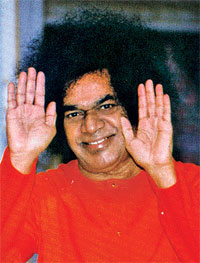
Bhagavan Sri Sathiya Sai Baba |
His supremely sainted activities confined not merely to the righteous
living but extended towards spheres educational, health, people’s
welfare and national development as well with his ideals of: “Help ever;
Love all; and Hate none” striking the golden mean of unity in diversity.
Indeed, he is a Maha Purusha, an incarnation most divine of our
times. Millions upon millions, in person and otherwise received his
blessings, solace and comfort. To all, he was a saint who guided,
relived and blessed them. Instances of his grace and magnificence speaks
volumes of his divinity. The many researched and scholarly works on his
life and mission have been living testimony to his super human powers.
His own writings under the title “Sathiya Sai Speaks” is a panacea for
all troubled souls. It is a wonder of wonders, astounding all!
This Godman of our times was not without his critics and agnostics.
Many who did not take him seriously subsequently fell prostrate at his
feet when they realised his divinity and super human powers. That was
another miracle!
Puttaparthi, then, which was an undeveloped land mass of over 100
acres, arid and dry, infested with snakes is now a spiritual paradise
with all modern comforts, a place of pilgrimage to all from east and
west.
As all have a date to end our eventful lives, Bhagavan Sri Sathiya
Sai Baba chose like Christ, the King, the Easter Sunday, to merge with
the Lord but his soul still remains with us to bless and succour us as
revealed in our scriptures.
Sri Sai Ram in glory remains as powerful as he was on the earthly
paradise to continue to cleanse our mortal sins and to stimulate
generations to come on the significance of our lives. The Omniscient Sai
with his greatest manifestations will live for ever! He is, indeed, GOD
INCARNATE as there are still many before him. OM, SAI RAM!
While we offer our homage to this Sainted Soul, we pray for His
Eternal Glory.
T N Punjaksharam
Jaffna.
|
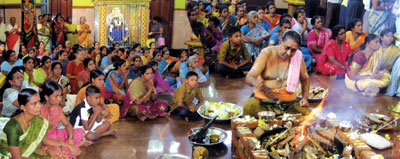
A special Yagna and Abiseka Pooja programme to mark “Guru
Matram” (change of jupiter) were celebrated at Hindu Kovils
islandwide recently. Here an event held at the Saruartha
Sitti Vinayagar Kovil Modera Colombo under the patronage of
Chief Priest Rev S Somasundarak Kurukkal. |
|

The annual Ther chariot festival of the Arulmigu Sri
Venkateswarar Maha Vishnu Kovil, Modera Colombo – 15 took
place this year under the patronage of a large number of
devotees. Here the chariot being taken in procession from
the Kovil to Sri Ponnambalawaneswarar Kovil, Kochchikade
Colombo – 13. |
|
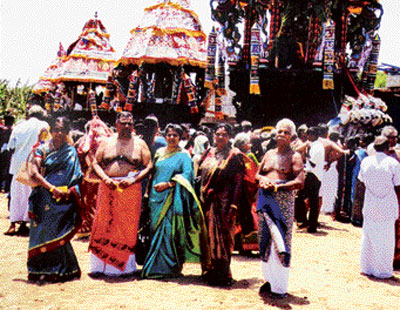
A special Yagna and Abiseka Pooja Programme to mark Guru
Matram (change of jupiter) was celebrated at Hindu Kovils
islandwide recently. Here an event held at the Saruartha
Sitti Vinayagar Kovil Modera Colombo under the patronage of
the Chief Priest Rev S Somasundarak Kurukkal. Pictures by A
Maduraveeran |
|
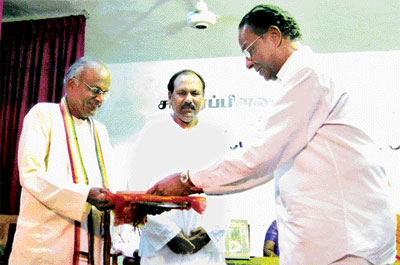
A religious book titled Then elangaiyn Porathana Kovilgal
(Ancient Hindu Kovils in South Sri Lanka) published by the
Hindu Religious and Cultural Affairs Department was launched
at the Colombo Tamil Sangam Wellawatta recently. Here the
maiden copy being presented by Prof S K Sittambalam to the
Chief Trustee, Sri Ponnambala Waneswarar Kovil Colombo D M
Swaminathan while author N K S Thiruchelvam (centre) looks
on. |
|



